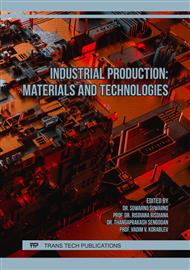p.3
p.11
p.19
p.29
p.37
p.47
p.67
p.83
Simulation of Commencement and Size of the Hot Spot in Permanent Mould Casting
Abstract:
The foundry casting process is complex and takes various stages to produce the desired component; as a result, simulation is necessary before manufacturing. Hot spots are areas that become thermally isolated and take the longest to cool, resulting in cavities during the solidification of the casting. So it is important to know about the hot spot location and size so that any casting designer can identify the hot spot behaviours before the casting. To predict the initiation of the hot spot, a 3D aluminium permanent mould casting model has been developed by Ansys Fluent. The suitable boundary and initial conditions such as temperature, pressure, convectional heat transfer coefficient, etc. are reasonably established in the simulation of Ansys Fluent. The simulation has been performed for varied pouring parameters i.e. pouring velocity and pouring temperature, to examine the beginning of hot spots. This study can predict the position and approximate size of the hot spots for various pouring conditions and it is found that a hot spot is commonly located below the riser.
Info:
Periodical:
Pages:
11-18
Citation:
Online since:
March 2023
Authors:
Price:
Сopyright:
© 2023 Trans Tech Publications Ltd. All Rights Reserved
Share:
Citation:



